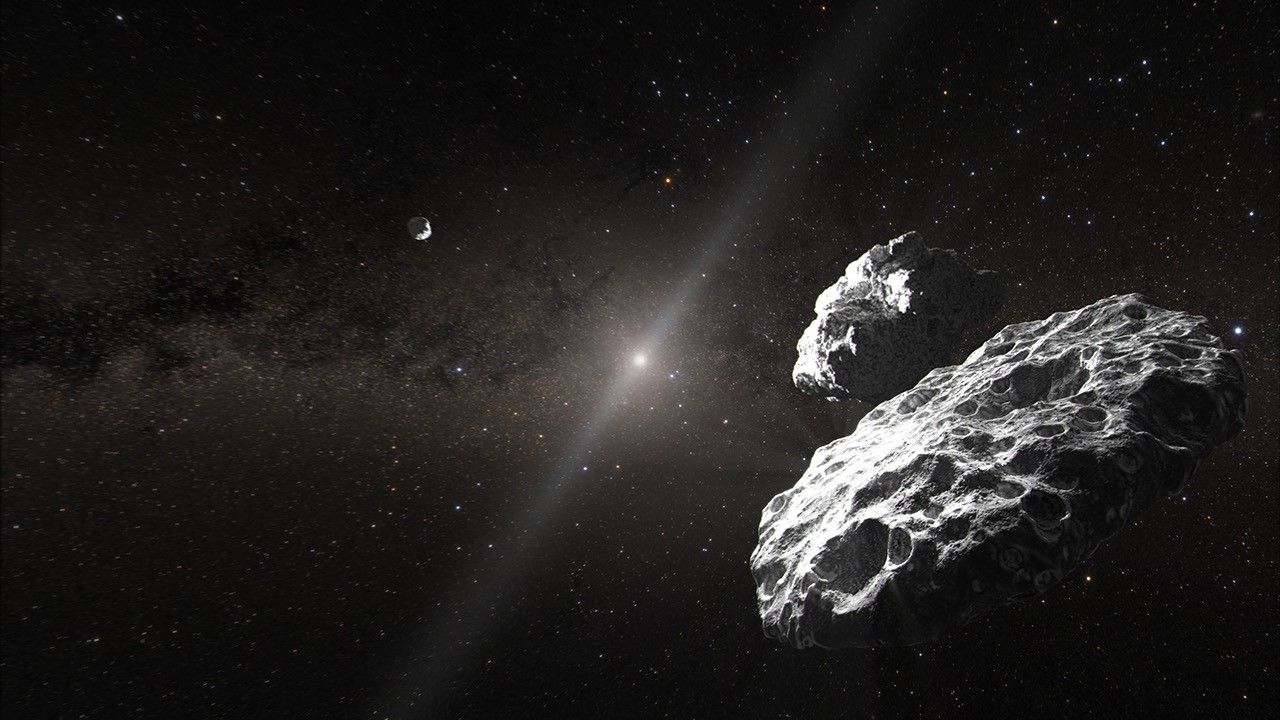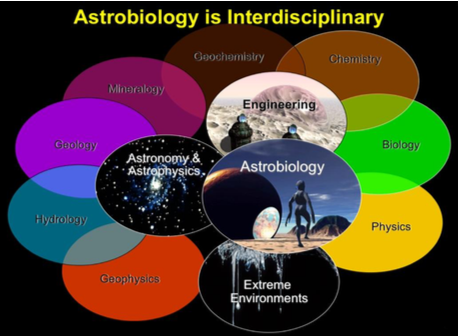Core Capability 7 – Astrobiology and Detection of Life
Astrobiology Highlights
The Space Science and Astrobiology Division was instrumental in establishing Astrobiology as a field and continues to make significant advancements in Astrobiology and Life Detection. We seek to understand the processes that provide continuity from the abiotic formation of organic molecules to the transformation of planetary environments by mature biomes. We have produced multiple biomolecules in laboratory experiments that simulate astrochemical processes in multiple environments, including laboratory and theoretical modeling of molecular clouds and radiation sources. We are linking biological interactions and functions with biogeochemistry and evolutionary biology to explore the relationship between life, habitability, and the factors that constrain the production and preservation of biosignatures. We are developing bioinformatics tools for evolutionary analysis of the emergence of biosignature-relevant traits, and have studied the degradation of organic biosignatures via reactions with mineral surfaces.
In our life detection efforts, we are:
- establishing an intellectual framework to interpret the detectable products of life processes and relevant methods and instruments to detect them
- developing the capabilities necessary to bridge the gap between the abiotic formation of organic molecules and the emergence of life
- exploring the prebiotic plausibility of chemical reaction networks developing novel experimental systems to examine processes needed to sustain protocells and to support and shape early evolution.
We explore the boundaries of habitability on Earth by clarifying the limits of life with respect to energy, water availability, and temperature. Our research into life detection and biosignatures in the solar system and exoplanets includes field campaigns and long-term environmental monitoring focused on novel biosignatures that have potential for remote detection on exoplanets and detection in situ by Solar System surface missions. We have investigated hopanoid biomarkers relevant to interpreting evidence of microbial metabolism in Earth’s early rock record. We continue to test in situ real-time life detection assay protocols for mitigating false negatives in geobiological samples from deep subsurface, hyper-arid, high elevation extreme environments. We have deployed new instrumentation (GC-IRMS, Raman microscope system) in support of these efforts.
A key component of our work is community and programmatic service: We continue to develop the Astrobiology and Habitable Environments Database (AHED), and have maintained the ongoing effort to update “Ladder of Life Detection”. We have begun to explore opportunities to inform requirements for planetary protection and contamination control (drill, sample handling), and provide literature reviews of biosignatures and astrobiology strategies.
Objective 7.1 – Connect Abiotic Formation of Organic Molecules to Emergence of Life
To meet this objective, we must understand the relationships between the processes that support the emergence of life, the organic inventory of the Solar System, and the organic content of the interstellar medium. There is a critical gap in the field of Astrobiology that separates astrochemistry from prebiotic chemistry and Ames is well positioned, perhaps uniquely so, to address this gap. We will expand work at Ames on abiotic production of metabolites and their associated reaction networks to understand potential routes from abiotic reactions to biological metabolism. We will continue to investigate the roles of radiation and minerals in the formation of molecules used by extant biology and the formation of other molecules that may play as yet unidentified roles in driving the origin of life. To meet this objective, we will also need to address geochemical processing of organic molecules delivered to planetary surfaces and determine its prebiotic relevance.
The origin of life is defined by the emergence of a system capable of open-ended Darwinian evolution. On Earth these evolutionary processes allowed life to emerge and proliferate, establishing dynamic systems that integrate small molecule reaction networks, functional and information polymers, and selectively permeable compartments. A comprehensive understanding of the mechanisms necessary for the emergence of life requires an examination of how all of these components can evolve as a single integrated system. Ames will continue to develop novel computational and experimental systems that capture the complexities of the multicomponent, early evolutionary processes that drove the emergence of life. Work under this objective also serves our efforts to understand habitability by establishing conditions compatible with emergence of life, and it establishes a starting point for the coevolution of life and its environments.
Objective 7.2 – Biological function and Habitable Environments: Coevolution of Life and its Environment, and Production and Preservation of Biosignatures
From the first, simplest, tenuous instances of life on Earth to the complex, global ecosystem that exists today, increasing biological complexity and the co-evolution of life and the physical environment have shaped this planet. Our understanding of biological processes, especially at the limits of life, on the early Earth or in unusual and analog conditions, is incomplete and it is therefore essential to advance our understanding of where and how life works on Earth, and the signatures that it makes and leaves behind, to inform the search for life elsewhere. Ames research seeks to understand how physical controls affect biological processes, interactions, and biological and geochemical dynamics to reveal when, why and how diagnostic biological signatures are produced and preserved.
Ames research couples’ molecular ecological tools with biogeochemistry under relevant habitability and life detection conditions and characterizes in situ biosignatures for early Earth, Mars, and exoplanets. Study of the co-evolutionary history of life and the physical environment, through theoretical and experimental studies of biological function, diversity, complexity, and the expansion of habitability, enables understanding of the nature of biological innovation at key branch points in Earth’s history in concert with studies of the geochemical record. Ames researchers will establish models for habitability and microbial metabolism on early Mars and ocean worlds. They will develop a quantitative framework for exploring the emergence of key traits and processes involved in evolution of the biosphere and the production of biosignatures through evolutionary and geologic time.
Objective 7.3 – Habitability Assessment, Biosignatures, and Life Detection in the Solar System and Exoplanets
The search for life requires an interdisciplinary approach to (1) constrain the limits or degree of habitability, (2) characterize diagnostic attributes of life (biosignatures) in the context of the environment, and (3) assess the preservation potential and in situ detectability of biosignatures on other planets and moons and in the geologic records of Earth and Mars. Ames investigators explore the boundaries of habitability on Earth by clarifying the limits of life with respect to energy, water availability, and temperature.
Division and Scientists will continue to participate in the in situ exploration of mineralogical and sedimentary indicators of ancient habitable environments on Earth and Mars. They will further enhance the application of microbial lipids and stable isotopes to identify and characterize signatures of early life and the evolution of our biosphere. They will investigate the transformation and preservation of biosignatures in Earth’s rock record.
Overall, the Ames team will employ a combination of laboratory, field analog research, and theoretical investigations in order to improve our understanding of the limits of life, expand the repertoire of biosignatures, and characterize the processes that determine their preservation and detectability. Accordingly, early TRL instrumentation will be developed to characterize geochemical evidence of past environments preserved in ancient rocks.
A new facility will conduct research in planetary protection and develop instrumentation for life detection. A Discovery Program ‘Icebreaker’ mission will be proposed to search in situ for biosignatures in ice-cemented soils on Mars. Ultimately the Ames team will contribute to investigations of samples returned from Mars.
Objective 7.4 – Support Programmatic Efforts and Serve Research Community

Basic research at Ames provides the foundation upon which to provide key support for the astrobiology and planetary science community. They Ames team will integrate its research efforts with newly-established Research Coordination Networks (RCNs) in Astrobiology. It will provide inputs on requirements for life detection, planetary protection/contamination controls, instrument development, and the selection of landing sites that address astrobiology objectives.
The newly established Center for Life Detection will provide resources for, and points of interface between, headquarters, mission and instrument development communities, and the broader research community engaged in life detection science.
Ames will continue to develop the “Astrobiology Habitable Environments Database” (AHED) to provide a central, high-quality, long-term data repository and discussion forum for mineralogical, textural, morphological, chemical, and isotopic information pertinent to astrobiology. The Ames team will continue to publish literature reviews relevant to astrobiology.





























